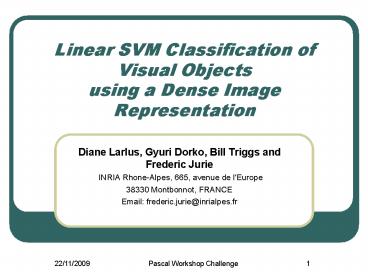Linear SVM Classification of Visual Objects using a Dense Image Representation
1 / 20
Title:
Linear SVM Classification of Visual Objects using a Dense Image Representation
Description:
cars. 9/28/09. Pascal Workshop Challenge. 15. bikes. 9/28/09 ... Are not critical issues, the most important. issue is the codebook and the way. it is computed. ... –
Number of Views:47
Avg rating:3.0/5.0
Title: Linear SVM Classification of Visual Objects using a Dense Image Representation
1
Linear SVM Classification of Visual Objects
using a Dense Image Representation
- Diane Larlus, Gyuri Dorko, Bill Triggs and
Frederic Jurie INRIA Rhone-Alpes, 665, avenue de
l'Europe - 38330 Montbonnot, FRANCE
- Email frederic.jurie_at_inrialpes.fr
2
Overview
- Similarities with the previous approach
- Geometry free method
- Based on codebook, used to encode images
- Differences
- Dense representation of images for building
construction interest point operators often
failed on small objects. - Images features (two different representations
are used) - Linear classifier
3
Codebook construction
Training Images
Quantization
- Feature space
- Raw pixel intensities (normalized) 15x15 windows
- SIFT description (128-d)
4
Image representation
- Images Representations
- (one vector per image)
- histograms
- Binary vectors
Training Images
Quantization
5
Dimensionality reduction
- Odd ratio
- Mutual information
- Gain in mutual information
- Svm based dimensionality reduction
6
Image classification
- Classifiers
- Naive Bayes
- SVM
- Linear
- Polynomial
- RBF
-
Binary classifiers
7
Keypoint Clustering the feature space
- Large number of vectors 10 millions
- K-mean gives bad results, because of unbalance in
cluster sizes - low of power, known as Zipfs law in text-based
word frequency analysis
8
Facing unbalanced densities
- Well know problem, solutions exist
- Sub-sampling
- Over-sampling
- Re-weighting
- We developed an on-line method based on
sub-sampling - uniform sampling of vectors
- produce largest clusters
- Re-sample the set of vectors (without sampling
in existing clusters) - On-line stop criterion (nb. of clusters, quality
of the quantization, quality of the
classification task , etc.)
9
Experimentswith the PASCAL dataset (test1 only)
- Classifiers
- Naive Bayes
- SVM
- Linear
- Polynomial
- RBF
- -gtparameters
- Feature space
- Raw pixel intensities (normalized) 15x15 windows
- SIFT description (128-d)
- -gtparameters
Image representation - binary vectors -
histograms
- Codebook
- Size
- Dimensionality reduction?
- Parameters of the clusterer
10
(No Transcript)
11
(No Transcript)
12
(No Transcript)
13
(No Transcript)
14
cars
15
bikes
16
motorbikes
17
people
18
Comments on the results
- Binary representation vs. histogram we are not
capturing texture but occurrences of
informative parts. - Linear SVM
- Dimensionality
- Dense vs. sparse
19
Conclusions
- In case of dense representation
- Feature representation
- Dimensionality reduction
- Image representation
- Classifier
- Are not critical issues, the most importantissue
is the codebook and the way it is computed. - Linear SVM / non-linear SVM
- Perspective
- is it possible to go further with this type of
approach ? - Is it the right way to evaluate
theclassification task (role of thebackground)
we should have background only images.
This is a car image!
20
Suggestion for next competitions
- Choose more carefully training / test images
- Annotate training images more accurately (20 of
120 motorbike images are labeled as motorbike
only while then contains humans too) - Test image should be related to training images
- Only allow to train object vs. background,
provide background images - Evaluation test images should have weights
(related to the visibility of objects).
Capability of detecting visible objects (of not
missing them) capability of detecting difficult
objects.































